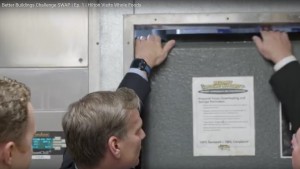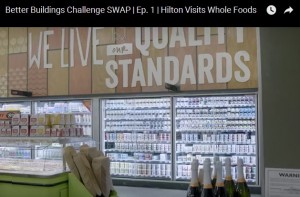The Better Buildings Challenge, a new reality Web series designed to create more knowledge about building energy efficiency, recently released its first three episodes. In the series, the energy management teams from Whole Foods and Hilton Worldwide swap teams and evaluate each other’s buildings in search of energy efficiency improvements that can be made. The show’s concept is based off of the Better Buildings Initiative, signed by President Obama in 2011, in an effort to “. . . set a national target of improving energy efficiency in commercial buildings by 20 percent by 2020.” This is the first of a two-part article series that will focus only on the episodes where the teams evaluate each other’s buildings. This article will detail the Better Buildings Challenge takeaways the Hilton team discovers while auditing Whole Foods, from kitchen, roof top unit, and lighting improvements.
Whole Foods
Kitchen
The Hilton team first examines the Whole Foods kitchen. Aaron Daly, Global Energy Coordinator for Whole Foods, notes that kitchens are a significant energy consumer. That’s an understatement. From small appliances to HVAC to lighting, “kitchens consume roughly 2.5 times more energy per square foot than any other commercial space.” What’s more, an Oxford Journal research paper, published in 2013, noted that, on average, 63% of a facility’s electricity consumption took place in the kitchen. That’s only on average. Our research suggests kitchen energy consumption can reach up to 75%.
Improving energy efficiency in kitchens mainly boils down to ventilation. Food preparation and ventilation consumes approximately 29% of the energy consumed in a kitchen. The byproduct of food preparation is heat and steam released into the air. Most kitchens will run range hood fans at full power throughout the day to ventilate the heat and steam. Often, these fans will remain on at full power, even when the kitchen is not busy. Installing a demand-controlled ventilation (DCV) system with variable-speed hood controllers can optimize the fans to run only when necessary, reducing energy consumption by up to 50%.
Building Envelope
The Hilton team investigates a walk-in refrigeration door that sits well below the door seal, creating a visible gap that allows air to move freely between both rooms. Effectively, the cool air from the air-conditioned room is lost, which forces the HVAC fans to run more often than necessary. While the lost energy from conditioned air escaping the room is critical, what’s even more critical is that the HVAC fans will need to run longer to recondition the refrigerated space. Tristam Coffin, Sustainable Facilities Coordinator for Whole Foods, notes, “For us, refrigeration is a big thing . . . . It’s the heart and lungs of our building and also has the largest energy as well as direct emissions impact for our facilities.”
HVAC fans are one of the largest energy consumers in any building. An HVAC system in a commercial building accounts between 40-60% of total energy consumption. The last thing an energy manager wants is their fan running more often than necessary. Installing economizers and controls can reduce energy consumption by up to 30%.

Energy Management System
Around the 3:30 mark, Tristam Coffin shows the Hilton team their energy management system (EMS). An energy management system can help reduce costs in a commercial facility by “. . . monitoring conditions and controlling energy-consuming equipment.” It allows energy managers to view how the building is using energy throughout the building, what is performing well, and what is having issues. This allows energy managers to come up with solutions with how to better control their energy consumption with real-time data. According to NHSaves, “A properly installed and maintained EMS can result in energy savings of 10 to 30 percent.”
Brian Mork, Director of Property Operations for Hilton San Francisco Union Square, and Randy Gains, Vice President of Operations for Hilton Worldwide, however, were concerned that the Whole Foods team wasn’t monitoring and controlling the system as well as they could. With few staff monitoring and controlling the EMS, trouble areas could be missed and opportunities for energy management could be lost.

Roof Top Unit
Around the 4:35 mark, the Hilton team takes a trip up to the roof to examine the roof top unit (or as they call it the make up unit), which is the central HVAC device for the entire facility. The first thing Randy Gains notes is, “It’s really important to make sure the coils are clean and that it’s working properly.” We touch upon the importance of these same issues in our tips for HVAC efficiency article. Proper maintenance is critical to ensure the system is running at optimal performance. If your HVAC, which consumes 40 to 60 percent of your entire building’s energy, is not running at peak performance, expect to waste a lot of energy and money.
Lighting
Most of the opportunities the Hilton team recommends are straightforward. There are almost always lighting improvements that can be made to any commercial building. New generations of lighting products come out all the time, and even an extremely sustainable business like Whole Foods can’t keep up with the number of new solutions that continuously become available. With that said, the Hilton team recommends some of Whole Food store’s T8 and compact fluorescent lighting could be upgraded to LED lighting.
Daylighting
Maxime Verstraete, Vice President of Sustainability for Hilton Worldwide, noticed that the front of the store, which receives a lot of natural light from large panel windows, has lights that remained on during peak daylight hours. Effectively, the natural daylight nullifies the need for that lighting grid to remain on. This type of energy efficiency is called daylighting. According to the Whole Building Design Guide, a program of the National Institute of Building Sciences, daylighting can save between 10 to 20 percent in commercial buildings. Although, most daylighting projects are not done as a retrofit, but more so as new construction or reconstruction.

LED Cooler Lighting
Not everything the Hilton team saw was criticized. Randy Gains loved the Whole Foods approach to showcasing their refrigerated products. Not only does LED cooler lighting provide top-of-the-line energy efficiency savings (up to 85% over traditional fluorescent lighting), but it also highlights the products within the refrigerated cases, leading to higher sales and revenue. As Gains notes, “That’s their jewelry box to selling to the customer.”

Stay tuned for the next Better Buildings Challenge takeaways installment where we will examine what recommendations the Whole Foods team has for the Hilton team.
The featured image was sourced from the Better Buildings Challenge website’s photo gallery.
All pictures were sourced from the video.




